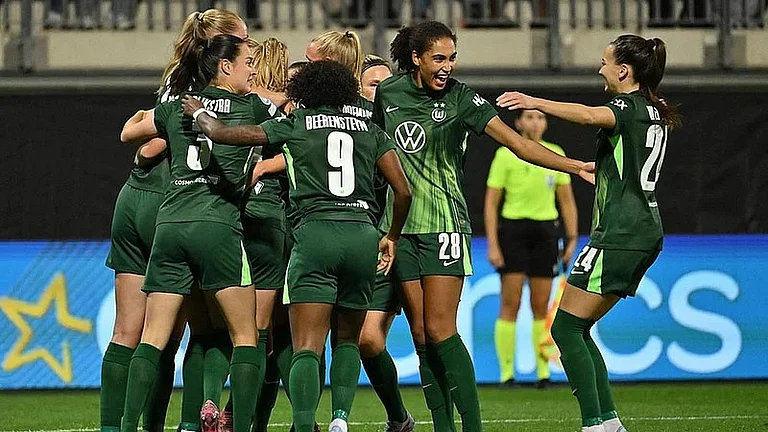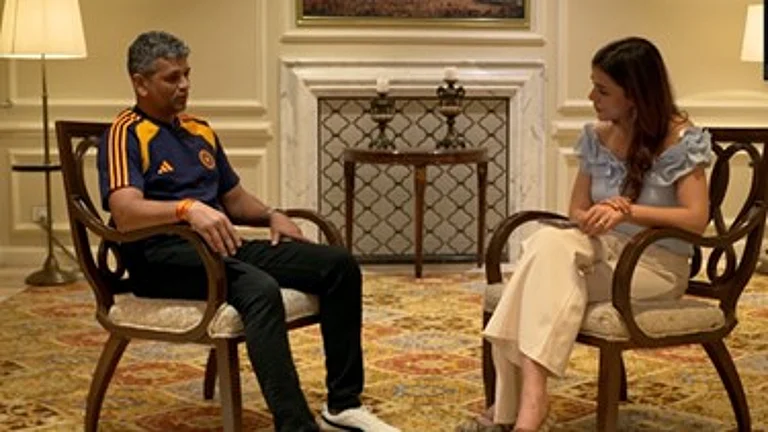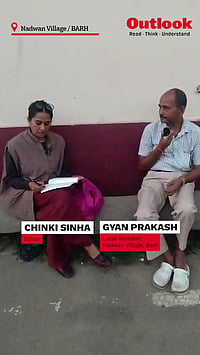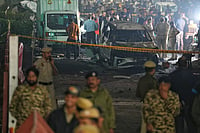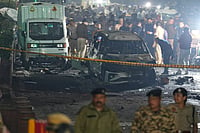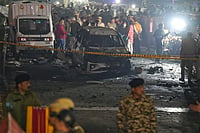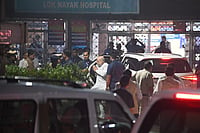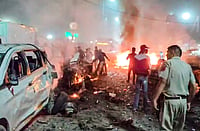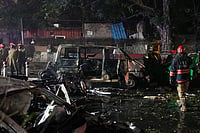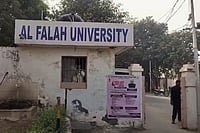- Boundaries can't be redrawn
- LOC can't become the permanent border
- Work to make boundaries irrelevant
- Self-governance
- Independence
- Autonomy
- Joint control and joint management
India's view
Restore all traditional economic, cultural, linguistic pre-Partition linkages that existed in the region. A new sense of interdependence will then emerge.
"I do not know what the ultimate solution will be," Manmohan Singh said.
Of all the people who watched the telecast of President Pervez Musharraf’s breakfast interaction with the Indian editors last Monday (April 18), none watched it more keenly than Prime Minister Manmohan Singh. At the time the telecast began, the prime minister was in a meeting at his 7 Race Course road residence. When the meeting ended, he plonked himself in a chair; sitting behind him was his National Security Advisor M.K. Narayanan, Principal Secretary T.K.A. Nair and media advisor Sanjaya Baru. Together they watched the telecast for the next 40 minutes, in silence. Explaining the changes under way in the subcontinent, Musharraf said the world had moved from the era of geo-politics to enter the era of geo-economics; trade and commerce have become the defining principles. On hearing this, Manmohan suddenly turned around to face the others behind him and beamed an expansive smile. The smile said it all: Musharraf was speaking the language Manmohan is comfortable with. It was, to use a cliché, music to the ears of those present in the room.
That the two leaders were speaking the same language, and had established a rapport, became obvious at the dinner on April 17 evening. Both Manmohan and Musharraf were so deeply engrossed in conversation that others noticed the two were peering around a flower arrangement and a candle-stand lying between them to establish eye contact with each other. The candle-stand was subsequently removed to facilitate the bonding. "Dialogue has already begun," remarked a guest sitting at the adjacent table. Senior government sources confirm that the Indo-Pak dialogue currently under way "is deeper than it looks. We are talking about more issues, and more substantially about the issues."
Three instances confirm this trend. It was Musharraf’s wish to include in the joint statement the word "irreversible" to describe the peace process. Second, both Manmohan and Musharraf agreed to not allow the situation in Siachen to drift and accepted that disengagement at the icy heights would be in the interests of both countries. There could be a meeting on this within a month. Third, on the Baglihar issue, Manmohan assured Musharraf that India would not, now or in future, violate the Indus Water Treaty with Pakistan, in either letter or spirit. Musharraf said the technical people in Pakistan had some objections. Manmohan’s response: "Let the technical people meet and sort it out." The ground is thus paved for a bilateral settlement, once such a technical meeting is scheduled. Sources say New Delhi is prepared to make minor design changes in the Baglihar dam to facilitate a solution—and to also signal India’s approach to problem-solving.
But the biggest achievement during Musharraf’s visit was the language of conciliation the key players adopted. Musharraf, Manmohan and foreign minister K. Natwar Singh all spoke about moving to a situation where borders become irrelevant. This has led to the formulation of a virtual framework for hammering out a solution on the Kashmir issue. The framework has three defining parameters: existing boundaries cannot be redrawn; conversion of the Line of Control (LoC) into a border isn’t a solution; and efforts are to be made so that boundaries become irrelevant. Though, as Musharraf pointed out at his breakfast meeting with Indian editors, this too can’t constitute a solution.
This may sound like a riddle rather than a framework. But the hazy contours of a solution are already discernible in the language senior government officials employ to characterise the soft border goal that India and Pakistan have upheld. As one official said, "While the de facto border of the LoC will remain, the pre-Partition linkages of the (J&K) region will become a reality. Partition severed a whole lot of links—economic, cultural and linguistic. The idea is to re-forge the linkages."
The central pillar of this reintegration process was erected at the time Musharraf permitted the Srinagar-Muzaffarabad bus service. Now, he has accepted the logic of cross-LoC synergies in terms of trade, agreed meeting points for divided families, pilgrimages and cultural interaction and an understanding that additional bus routes (Poonch to Rawalkot) would further bolster the soft-border goal. Thus, all the CBMs (confidence-building measures) on Kashmir that India had proposed are now in play, except joint promotion of tourism and exploring prospects for cooperation in joint management of forestry resources, etc.
The next stage, sources say, will entail undertaking cooperative solutions to common issues in the region. Also, Islamabad has taken a giant conceptual leap by agreeing to reactivate the Joint Economic Commission that has been moribund since the late ’80s. The joint statement also says the consulates in Karachi and Mumbai would be re-opened before 2006 and the Khokrapar-Munabao transport link would be activated by January 2006. In other words, progress on other issues would no longer be held hostage to Kashmir.
What has brought about Musharraf’s change of heart? Senior government sources cite these reasons to explain Pakistan’s changing mindset:
- A broad consensus has emerged both in Pakistan and India that a productive engagement represents the only way forward in bilateral ties.
- The direction and pace of the engagement was set in train once Manmohan and Musharraf met in New York last September without note-takers or aid, one to one, where each arrived at a clear assessment of the other’s strengths, weaknesses and compulsions.
- Just as India feels it shouldn’t be left behind China’s scramble for economic and political power, Islamabad has the same apprehensions about New Delhi. It must seize the moment now or run the risk of losing out in the shifts of global power plates.
- Pakistan’s perception of terrorism has changed. Previous belief that it was possible to have a segmented approach—take action against the Taliban and Al Qaeda and wink at Kashmiri militant groups—has been found impossible. Jehadis of all hues have strong interlinkages.
- Border-fencing combined with better intelligence and more focused targeting in Kashmir has reduced the terror pool in Kashmir from 3,000 combatants to about 1,500. An unduly harsh winter and lack of access to critical supplies are other factors for the dwindling terrorist numbers.
- Change in the international environment has compelled Pakistan to become reasonable in its relationship with India. New Delhi’s ties with both US and China, two traditional pillars in Pakistan’s calculation, look poised for a significant, deeper overhaul. Beijing’s endorsement of New Delhi’s aspiration for the UN Security Council seat and talk of global partnership have made Islamabad reassess the merits of its earlier India policy.
Obviously, a lot depends on how quickly and purposefully Musharraf inspires the bureaucracy there to move forward on the areas that India and Pakistan are in agreement. Senior sources, however, affirm that Musharraf is a changed man now. "Both the prime minister and president want to cut through the historical baggage and see if they can take it forward," said a source. "There is a realisation that you can’t construct a solution based on pure hope and sheer fantasy. They have to be based on ground reality."
In India, the only section unhappy with Musharraf is the Hurriyat. He told its squabbling leaders to "use your brains" as he met them in three different groups: Syed Ali Shah Geelani, Mirwaiz Umer Farooq and lastly Shabir Shah and Yasin Malik. That he shook the hands of people like Mehbooba Mufti and Omar Abdullah shows he now accepts that they represent a section of the Kashmiris. This, in a way, marks a moving away from the Pakistan line that the Hurriyat is the sole representative of the Kashmiris, though it doesn’t mean Musharraf has abandoned the Hurriyat as a card. What’s to be seen is whether the Hurriyat will itself step forward to talk to New Delhi.
If a soft border is not the solution and only a staging post for a final settlement, what would that be? These are still early days and as the prime minister pointed out: "I do not know what the ultimate solution will be."







